FEATURES|VEHICLES|Vajrayana
Kalmykia: Lore and Memory at the Far Side of the Buddhist World
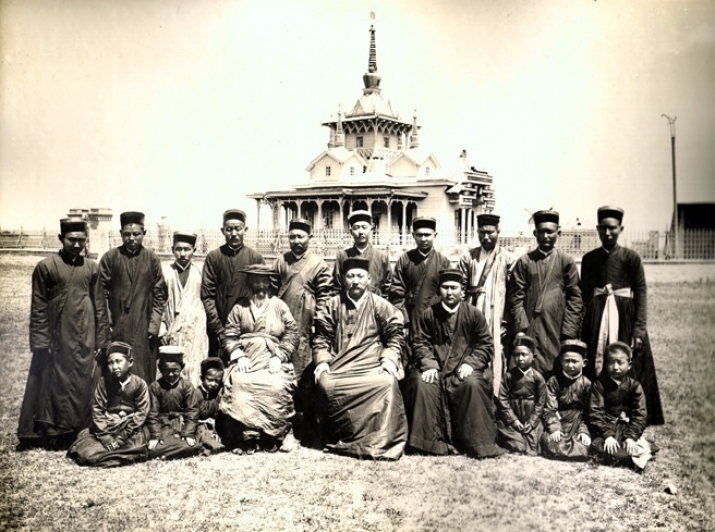 Kalmyk lamas in the Bolshederbetovsky ulus (district). From the G. N. Prozritelev and G. K. Prave Stavropol State Historical-Cultural and Natural-Landscape Museum-Reserve
Kalmyk lamas in the Bolshederbetovsky ulus (district). From the G. N. Prozritelev and G. K. Prave Stavropol State Historical-Cultural and Natural-Landscape Museum-ReserveOne could be forgiven for imagining the Buddhist republic of Kalmykia to be an uneventful and empty place. A Russian federal subject of less than 300,000 people, the distances between its sparsely populated cities are long. Bumpy, uncomfortable roads stretch across spacious, windswept plains that appear the same wherever one looks. Kalmykia’s capital, Elista, had a provincial, sleepy atmosphere even during the relatively important international conference held there in October (“Buddhism in dialogue between Eastern and Western cultures: Past, Present and Future”), which I was fortunate to be able to attend. True to its time-themed sub-heading, the conference’s objective was to promote awareness of the region’s spiritual and cultural vibrancy. Kalmykia’s shadjin lama (head lama), Telo Tulku Rinpoche, has invited scholars and specialists to give lectures and seminars here ever since the 1990s as part of his mission to promote Buddhist and cultural activities in the region.
“The Buddhist republics are poor and lack the prestige of the big cities,” he admitted in one conversation we had. “But I think it’s good for scholars to have a sense of spiritual purpose while studying Buddhism, not just to talk to their own circles of academics in ivory towers. Scholars [from Russia as well as overseas] can work with our religious institutions to preserve our culture and heritage.” Attracting young students (many of whom leave for better professional opportunities in Saint Petersburg or Moscow) to study Kalmyk cultural preservation is becoming an increasingly urgent priority. Given the “Definitely Endangered” status accorded by the UN to the Kalmyk language, Telo Rinpoche is confident that students who study the conservation of Kalmyk culture will be sought after for their unique skills.
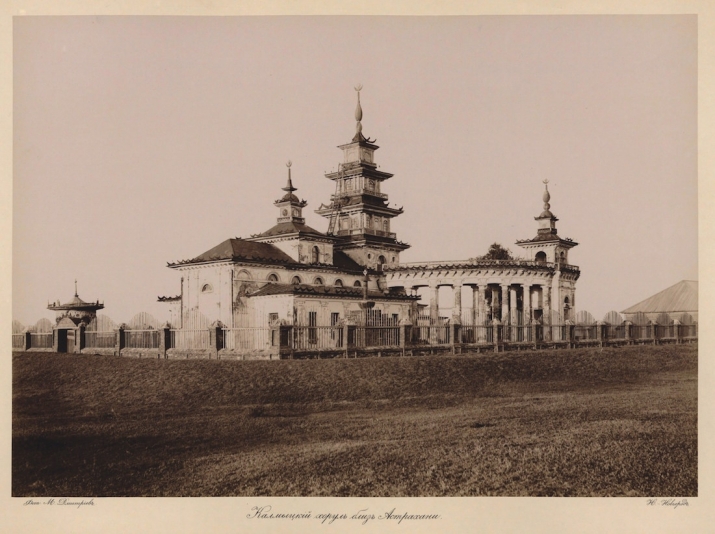 A khurul dated to 1890. From Palmov Kalmykia Republican Museum of Local Lore
A khurul dated to 1890. From Palmov Kalmykia Republican Museum of Local LoreAlthough this region south of the Volga River is quiet, it is not insignificant. The republic is located on the Pontic-Caspian steppe, temperate plains stretching out toward the Caspian Sea in the south and to the forests of old Germania and the taiga (boreal or snow forests) of Russia in the north. This home to the Proto-Indo-European cultures is part of the vast ecoregion called the Eurasian, or Great, Steppe. Geography shapes history, and the Great Steppe connects the Pontic-Caspian to the cultures and societies of Europe and the whole of Asia. On a map, the distance between present-day Kalmyks and their ancestral homeland, the Mongolian grasslands, covers almost the entire Eurasian Steppe. Their journey in the 17th century to the far side of the world, the westernmost limit of Buddhism until the 20th century, has been marked by energetic adaptation and cultural fusion, mass exoduses, and dogged survival.
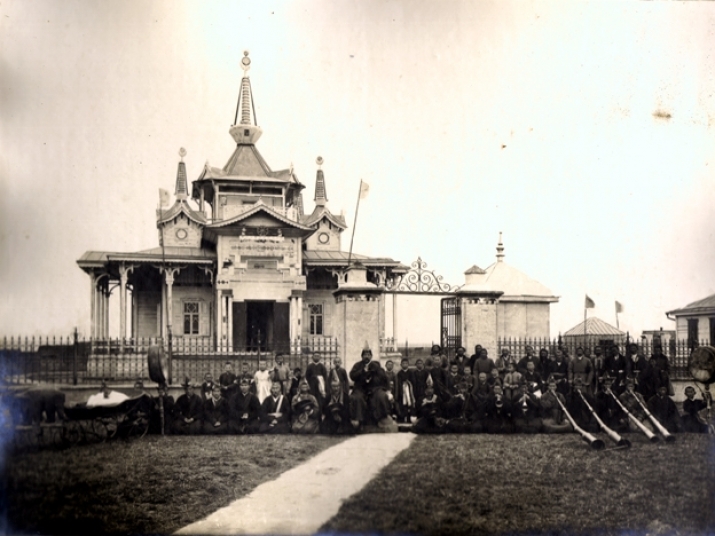 Kalmyk lamas near a khurul. From the G. N. Prozritelev and G. K. Prave Stavropol State Historical-Cultural and Natural-Landscape Museum-Reserve
Kalmyk lamas near a khurul. From the G. N. Prozritelev and G. K. Prave Stavropol State Historical-Cultural and Natural-Landscape Museum-ReserveThe Kalmyks are devoted to the Dalai Lama and the Gelug school of Tibetan Buddhism. The fusion of enlightened Dharma and Mongolian folklore can be spotted at the main gate of the recently built Golden Abode of Buddha Shakyamuni, Elista’s largest temple. The statue standing watch in front of a waterfall staircase is a kindly, bearded guardian called the White Old Man (“Sagaan Ubgen” in Mongolian; “Tsagan aav” in Kalmyk). He is a worldly spirit, one you can supplicate for more children or prosperity, but like so many indigenous divinities, was assimilated into the Buddhist pantheon of Dharma protectors by at least the 17th century.
Before the Turkic word “Kalmyk” first appeared in a Russian document dated to 1574, the roughly 270,000 Mongolians moving westward from Mongolia’s Altai region were called different names. Broadly, they were part of a loose federation called the Oirats. However, as Elza Bakaeva wrote in an article about Kalmyk identity, “The adoption of this ethnonym [Kalmyk] differed among the various ethnopolitical groups (Torghut, Derbet, and Khoshut) that afterward melted into one ethnicity: the more intensively a group and its leaders interacted with Russia, the more the name was used” (Bakaeva 2014, 32).
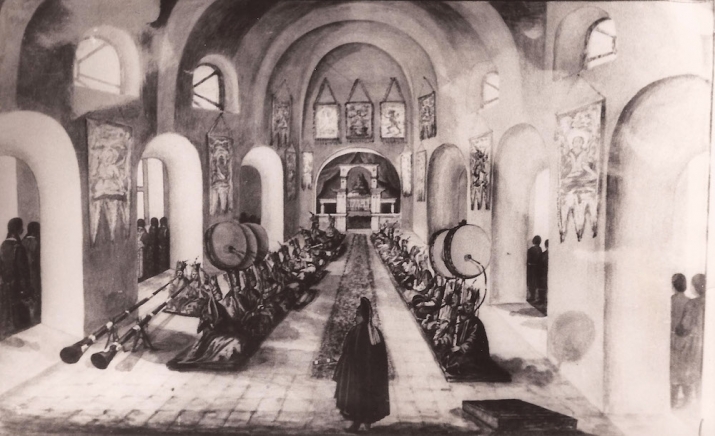 Illustration of a khurul interior. From Palmov Kalmykia Republican Museum of Local Lore
Illustration of a khurul interior. From Palmov Kalmykia Republican Museum of Local LoreThe reasons for the Kalmyk migration are disputed, and range from a desire to emulate the Mongol conquests of Europe in the 13th century to prospects for Russian trade to a lack of grazing pastures. The earliest records of Kalmyk-Russian encounters date to 1606, when the Russian town of Tara received a Torghut diplomat, and by 1609 the Kalmyks had voluntarily become nominal subjects of Russia (Bakaeva 2014, 33–34). Shortly thereafter, the celebrated Oirat Buddhist cleric Zaya Pandita (1599–1662), who had studied under the 4th Panchen Lama (1570–1662), diligently propagated the Gelug school among the Mongolian ethnopolitical groups (including the Kalmyks). These groups had in fact been allied to the Gelug school since the rule of the Mongolian leader Altan Khan (1507–82), who bestowed the first Dalai Lama title on Sonam Gyatso (1543–88). Thanks to the westward migration of the Kalmyks, the lower Volga became the region with the oldest Buddhist presence in Europe.
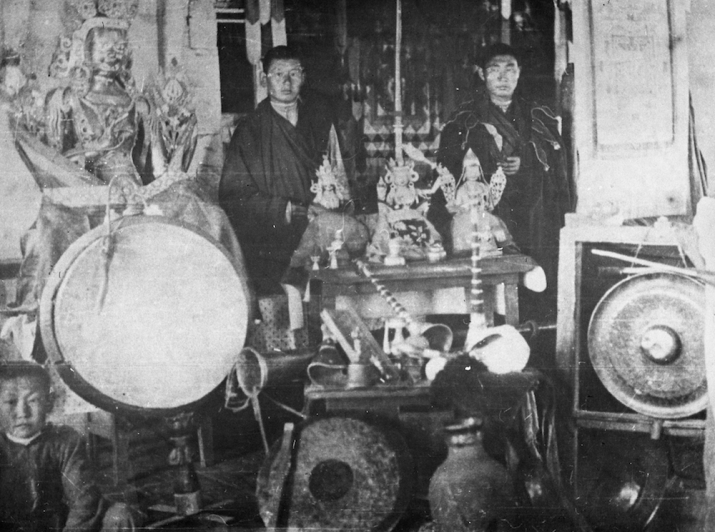 Kalmyk shrine. From Astrakhan State United Historical and Architectural Museum-Reserve
Kalmyk shrine. From Astrakhan State United Historical and Architectural Museum-ReserveTwo major displacements continue to be remembered as great betrayals by the Russian state. The first is the mass exodus in 1771 to Dzungharia (now the Xinjiang Uygur Autonomous Region, it had been under the rule of the Qianlong emperor [r. 1735–96] since 1757), when Ubashi Khan led a large number of Kalmyks to flee the increasingly oppressive policies of Catherine the Great. This prompted her to abolish the Kalmyk Khanate, which had been founded in 1630. The second is the Soviet deportation of 1943–57, which claimed up to about half of the Kalmyk population. Nearly all Buddhist institutions were closed or demolished, and monks were forced to disrobe or be killed. Autonomy was only regained after the new republic was founded on 29 July 1958.
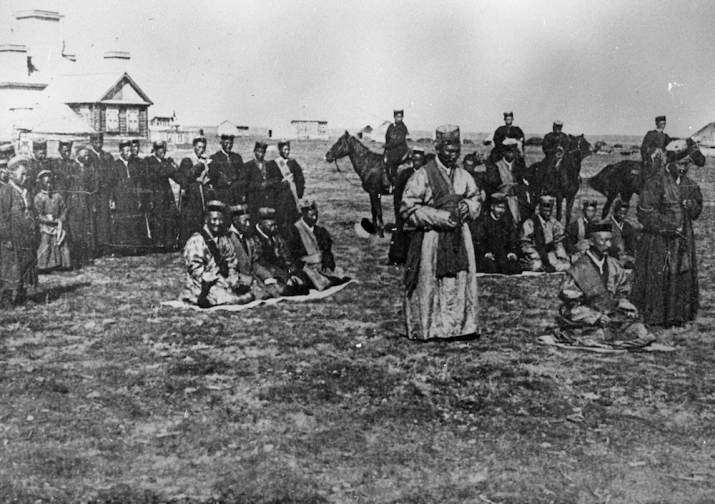 Buddhist ritual on the steppe. From Astrakhan State United Historical and Architectural Museum-Reserve
Buddhist ritual on the steppe. From Astrakhan State United Historical and Architectural Museum-ReserveIt is difficult not to feel a sense of loss when looking at black-and-white photographs and drawings of “old Kalmykia,” the Kalmykia from the 17th to 19th century before its almost total destruction by the Soviets. These images can be found at institutions like the Palmov Kalmykia Republican Museum of Local Lore, Kalmyk State University, and the Astrakhan Museum. They contain memorabilia of Kalmyk history: the earliest students that went to university, heroes and heroines of the Second World War, portraits of past and present politicians and scholars. Photographs at the Golden Abode also capture what were once common sights: the khurul (monasteries for teaching liturgical languages, scriptures, and philosophy), choira (religious colleges for astrologers, philosophers, and physicians), and syume (permanent temples).
My favorite drawing shows a magnificent ritual hall resembling the rock-cut chaityas of India, complete with a grand hall, colonnaded cloister, and high arched ceiling. It is a nod to Buddhist continuity across time and space: from India’s chambers of stone to Tibet’s mandala-inspired architecture, all the way to their Mongolian-Kalmyk counterparts near the lower Volga. These old structures have entirely vanished from the contemporary landscape.
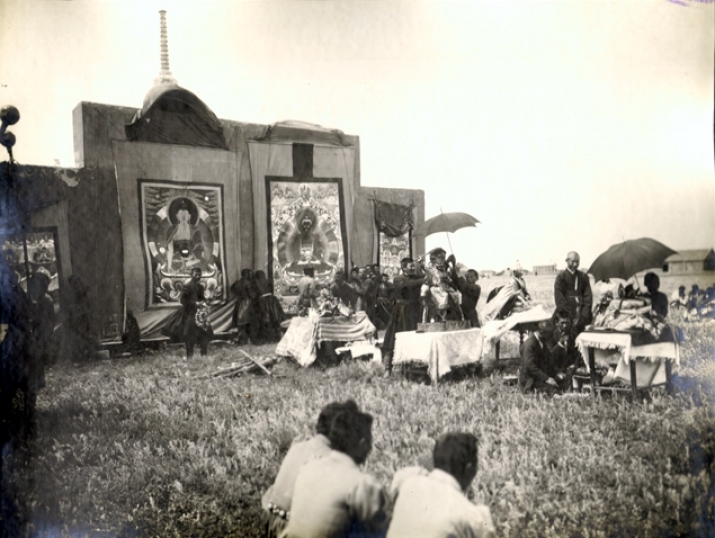 Prayer on the steppe with thangka images. From the G. N. Prozritelev and G. K. Prave Stavropol State Historical-Cultural and Natural-Landscape Museum-Reserve
Prayer on the steppe with thangka images. From the G. N. Prozritelev and G. K. Prave Stavropol State Historical-Cultural and Natural-Landscape Museum-ReserveModern Kalmyks inhabit a curious cultural and political space. The revival of their culture and religious practice is recent and incomplete. They feel great pride in having served as Cossack-like protectors of Imperial Russia’s southern border against Persia and the Ottomans, and in dying for the Soviet Union in the Great Patriotic War. But they feel just as proud of their cultural and religious identity as Buddhists cast in opposition to indifferent or malicious overlords. It is a peculiar interplay between piety, grievance, and patriotism that sustains their understanding of Kalmykia as a frontier of Eurasian Buddhism—their beloved home, yet not fully their homeland.
References
Bakaeva, Elza Petrovna. 2014. “Kalmyks, Oirat Descendants in Russia: a Historical and Ethnographic Sketch.” In Senri Ethnological Studies, no. 86: 31–54. http://ir.minpaku.ac.jp/dspace/bitstream/10502/5330/1/SES86_05.pdf.














